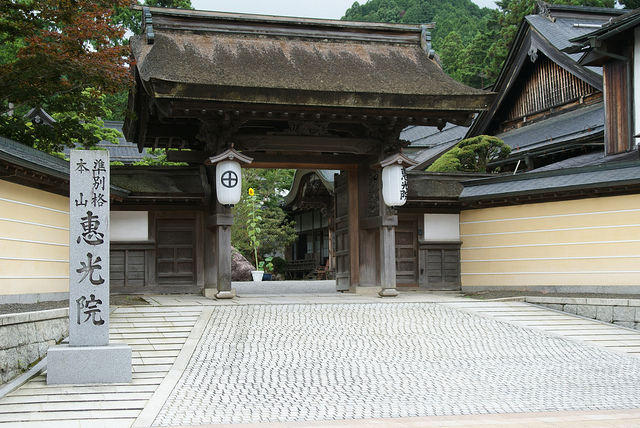
photo by Raphaël Thiémard
In accordance with the enthusiastic tourism campaign by Japanese government and local governments, the number of foreign tourists visiting Japan keeps soaring in recent years. While shortage of accommodations has been one of the biggest concerns in Japanese tourism industry, temple lodgings are becoming conspicuous especially among Europeans and North Americans. Originally, temple lodging are open just for Buddhist monks and pilgrims, but now most of them accept tourists as well. In fact, temple lodgings has been recognized as attractive accommodations associated with special Buddhist experiences and distinguished from other accommodations. One downside of temple lodging is rather inflexible services for foreign tourists comparing to hotels and ryokans. In fact, many people had their Japanese friends to make bookings for them. However, some temples have started bi-lingual service to encourage more international guests to understand Japanese Buddhism better. This column will introduce temple lodgings that offer services in English for guests who don’t speak Japanese.
Ekoin, Mt. Koya (Wakayama prefecture)
Mt. Koya, the sacred place of Shingon Esoteric Buddhism founded by Kukai 1200 years ago. In Mt. Koya, there are 117 branch temples of Kongobu-ji, the headquarters of Koyasan Shingon Esoteric Buddhism, and 52 temples out of 117 run temple lodging. In the past few years, the number of foreign tourists who stay in a temple lodging has been soaring up along with the rapidly increasing attentions from them to Mt. Koya. To quickly correspond to the demands, temples in Mt. Koya has been strengthening bi-lingual services. Primarily, Ekoin has a few English-speaking monks who can introduce accommodation facilities, explain the teachings of Shingon Esoteric Buddhism or any other questions. At “Okunoin Night Tour”, the most popular activity at Ekoin, a tour guide monk talks with participants about the founder Kukai, backgrounds of Shingon Esoteric Buddhism, stories about Okunoin, the history of Mt. Koya and more. Of course, other activities such as sutra copying and meditation class are available. Online bookings and inquiries can be made via website.
Ekoin
Address: 497 Koyasan, Koya-cho, Ito-gun, Wakayama
TEL: 0736-56-2514
Muryokoin, Mt. Koya (Wakayama prefecture)
Same as Ekoin, Muryokoin is one of the Shingon Esoteric Buddhism temples located in Mt. Koya. This temple has been deeply involved in international exchange, accepting many monks from overseas countries. The swiss master, who is fluent in multi-languages and have been working at Muryokoin for over 20 years, is especially well known here for his dedicated works. You may have a chance to talk with him if the timing is right. Also, guests can attend a 90-minutes full morning service to see sutra reading and fire ceremony from 6 o’clock. Donations are appreciated at the morning service. Bookings and inquiries can be made online or by phone.
Muryokoin
Address: 611 Koyasan, Koya-cho, Ito-gun, Wakayama
TEL: 0736-56-2104
Gyokuzoin, Mt. Shigi (Nara prefecture)
Chōgosonshi-ji Temple is located in Mt Shigi, where Prince Shotoku offered a prayer to the gods for victory over his opponents. Among three temple lodgings within the site of Chōgosonshi-ji Temple that has over 1100 years history, Gyokuzoin particularly puts effort to accept guests from foreign countries. Bookings can be made in Japanese, English and German, and guests are warmly welcomed by English-speaking monks or the chief priest. Special programs including sutra copying, picture tracing of a Buddhist image, meditation and general works are available for visitors. In addition, guests staying overnight can attend the morning fire ceremony which starts at 5 o’clock. There are many more historical buildings other than Gyokuzoin within the vast temple grounds filled with tranquil air. Early in the morning and evening is the best time to stroll around.
Gyokuzoin
Address: 2280 Heguri-cho, Ikoma-gun, Nara
TEL: 0745-72-2881
Shunkoin, Myoshin-ji (Kyoto prefecture)
Zen Buddhism is often presented as a typical form of Japanese culture, then an image of meditating Zen Buddhist monk may be the first thing pops up in your mind when you think of “Japanese culture”. Myoshin-ji Temple in Sakyo-ku of Kyoto city, the headquarters of the Myōshin-ji branch of the Rinzai Zen school, is well known for the largest Zen-temple network in Japan. Among thousands of related temples, Shunkoin is most enthusiastically put efforts into international exchange. The accommodation building named “Tetsuryu-kutsu”, meaning the Cave of Enlightened Dragon, is open only for non-Japanese guests. Each room has toilet, shower and air conditioner, and there is communal kitchen and dining area. Accommodation plan in Shunkoin is no-meal plan only. Guided tour, meditation class can be booked separately. All bookings and inquiries can be made by contacting international exchange personnel over the phone or via email.
Shunkoin
Address: 42 Myoshinji-Cho, Hanazono, Ukyo-Ku Kyoto
TEL: 075-462-5488
What we think, we become
Temple lodging is not just about seeing historical Buddhist constructions, you can also experience everyday Buddhist trainings. Because temple lodgings are training field for Buddhist priesthood in the first place, not hotels or ryokans which offer perfect services, may experience few inconveniences such as communal bathroom and toilets or curfews. But extraordinary moments that can never be experienced in ordinary sightseeing tours keep attracting many more visitors and the number of returning visitors is soaring every year. Also, more service improvements for inbound tourists is expected. If you are looking for a good accommodation in Japan, add temple lodgings to your key words.
Related Article:
Temple lodging: Touch the world of Japanese Buddhism
